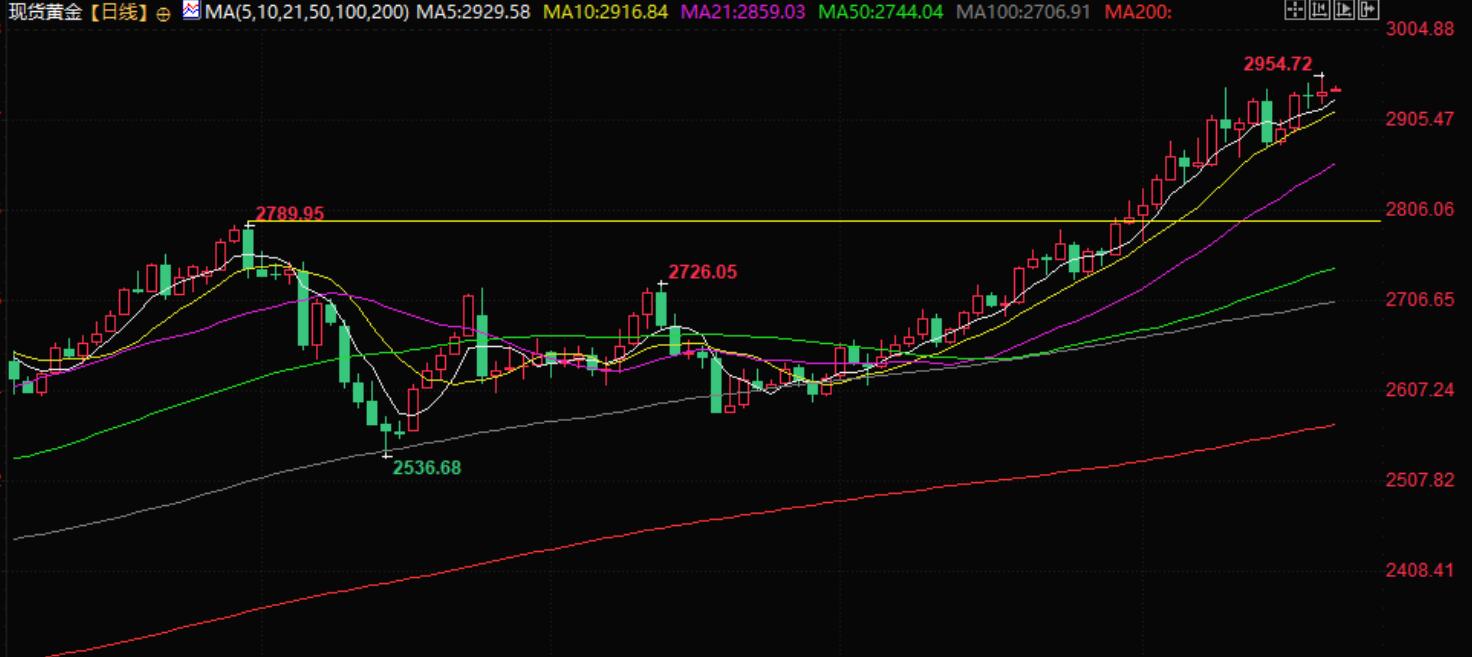Safe haven demand boosts gold prices to hit historic highs for the tenth time this year
On Friday morning (February 21st), spot gold fluctuated narrowly in the Asian market, currently trading around $2941.06 per ounce. Gold prices hit a record high again on Thursday, reaching a peak of $2954.72 per ounce, the tenth record high set so far this year. Worries that US President Trump's tariff threat could trigger a global trade war have stimulated safe haven demand for gold, leading to a decline in US dollar and Treasury yields and providing an opportunity for gold prices to rise.
Spot gold closed at 2939.14 on Thursday, up about 0.2%. So far this year, the gold price has risen by about 12%.
Peter Grant, Vice President and Senior Metals Strategist at Zaner Metals, said, "The ongoing trade tensions continue to raise concerns about inflation and economic growth, thereby stimulating interest in gold as a safe haven asset
Trump said on Wednesday that he will announce tariffs on wood, cars, semiconductors, and pharmaceuticals "next month or earlier".
Since taking office on January 20th, Trump has imposed a 10% tariff on Chinese imports and a 25% tariff on steel and aluminum.
We continue to see central bank buying... this has been the case so far this year. This is one of the main fundamental factors supporting gold prices, "said Phillip Streible, Chief Market Strategist at Blue Line Futures." We also saw ETF funds flow into the gold market for three consecutive days
Swiss customs data shows that Swiss gold exports increased year-on-year in January, with supply to the United States soaring to its highest level in at least 13 years.
The US dollar fell against major currencies on Thursday as investors took a step back to evaluate President Trump's latest tariff plan. The number of initial jobless claims in the United States only slightly increased last week, indicating that the labor market remained stable in February.
The report released by the Department of Labor on Thursday has not shown any indication that the massive layoffs and significant spending cuts by Republican President Trump's administration have had an impact on the economy.
Economists predict that the related impact will spread to the private sector, and they say it is too early to feel the negative effects. In recent days, the Department of Government Efficiency (DOGE) led by billionaire Elon Musk has laid off thousands of federal government workers, ranging from scientists to park rangers, most of whom are on probation. This department was created by Trump.
As of the week of February 15th, after seasonal adjustment, the number of people who initially applied for unemployment benefits from the state government increased by 5000, reaching 219000. Economists predict 215000 people.
As of the week of February 8th, the number of renewed unemployment benefits, which measures recruitment, increased by 24000 seasonally adjusted to 1.869 million.
Another report shows that the Philadelphia Fed's monthly manufacturing index plummeted 26.2 points from 44.3 in January to 18.1 in February, the largest decline in nearly five years, which also put slight pressure on the US dollar.
The growth momentum of the US economy is slowing down... without providing support for the US dollar, "said Boris Kovacevic, global macro strategist at payment company Convera. The hawkish monetary policy of the Federal Reserve... can only boost the US dollar to a certain extent, and the suspension of interest rate hikes has been completely digested
The US dollar index fell 0.78% on Thursday, closing at 106.35, the lowest closing price since December 10th, providing support for gold prices.
The yield of US treasury bond bonds fell on Thursday after comments by the top US financial official eased concerns about the upcoming increase in the auction size of long-term treasury bond.
The yield on the 10-year US treasury bond bond fell 3.4 basis points to 4.501% on Thursday.
St. Louis Fed President Alberto Musalem mentioned on Thursday the two major risks of rising inflation expectations and difficult to cope with stagflation, highlighting the potential difficult choices facing the Fed.
Chicago Fed President Austan Goolsbee said on Thursday that he expects the reference indicators used by the Fed to set inflation targets will not be as "concerning" as the previously released Consumer Price Index (CPI) data.
Traders are concerned that the tariffs planned by US President Trump will exacerbate already severe inflation.
The market is also paying attention to geopolitical developments. On Wednesday, Trump condemned Ukrainian President Zelensky as an "unelected dictator".
However, Zelensky adopted a more constructive tone on Thursday. He stated that Ukraine is ready to work quickly and tirelessly to reach a strong and practical investment and security agreement with the United States. He said on social media that he had a "good discussion" with US President's Ukrainian envoy Kellogg.
This trading day will also release the manufacturing PMI data for February in European and American countries, as well as the annualized total sales of existing homes in January in the United States. Investors need to pay attention. Additionally, it is necessary to continue monitoring news related to Trump and speeches by Federal Reserve officials.

Tips:This page came from Internet, which is not standing for FXCUE opinions of this website.
Statement:Contact us if the content violates the law or your rights
